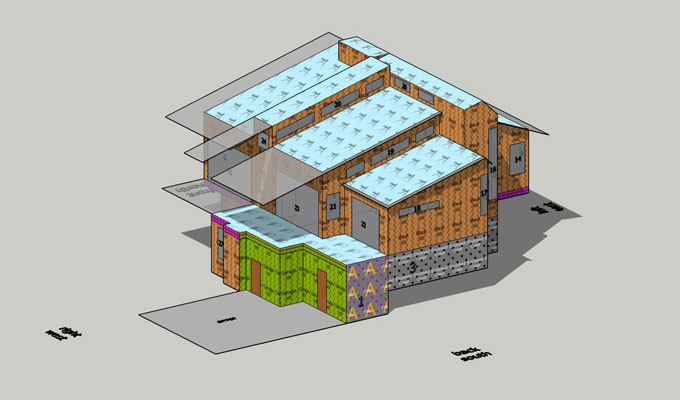What is energy modeling and why would I want it?
Basically, energy modeling software creates a mathematical simulation of your building over time to estimate how much it will cost to operate. It figures out how much heat is lost through every square foot of the envelope and how much heat is gained by the sun shining through the windows every year. It uses historical weather and solar data to calculate how much heat you will need to put into or remove to keep the indoor environment comfortable. And it can put this data in terms of dollars spent on fuel and utilities.
What’s the point? Optimization. We can swap different windows, adjust overhangs, try differing amounts of insulation, etc. and see what the result to the loads are, so we can find the sweet spot for your particular building. Knowing how much it costs to operate your building will allow you to calculate a return on investment for monies spent on energy conservation upgrades. For example, solar will pay for itself in the long run, but what is the payback period 5 years? 10 years? 20 years? Is it better to add continuous exterior insulation or buy better windows? Is it more cost-effective to add insulation to the attic or buy a few more solar panels?

So what is a HERS Rating?
The RESNET HERS Rating protocol is a nationally standardized energy modeling system, just for houses, that lets us get to the answers relatively quickly and makes results consistent and comparable across the country.
The value of a HERS Rating over just energy modeling comes in four ways.
- Code compliance- HERS Ratings supersede the rigid rules of the energy code and gives you flexibility.
- Third-party inspections- we inspect at rough to look for problems with air barriers and insulation. Having an air-tight envelope not only saves energy, it helps prevents rodents, bugs and dust from getting into the house. We grade insulation on the quality of its installation. If we find less than perfect installation, we bring it to the attention of your GC and he can have it corrected before it is too late.
- Rebates- many rebates are only available to those that receive a HERS Rating.
- Resale- the score goes on the MLS report so buyers get a sense of how efficient the house can be (like a MPG sticker for a car). Embedding the value of energy features in the value of the home also makes it easier to invest in features that have a longer return on investment.
What energy modeling doesn’t do…
- The model doesn’t know how much anything costs, except gas and electric. So it will not do a cost benefit analysis without help from the rest of your team.
- It is not the same kind of zoned load calculations used by HVAC designers to size ductwork or radiant tubing layouts. You will still need a heat/cooling/ventilation distribution design. It will tell us how many kBtu the furnace or boiler should produce, but not how to get the right amount of heat to every corner of the house to maintain comfortable temperatures.
- It is just an estimate. Occupant factors, like where the thermostat is set, will skew the numbers accordingly.
Why choose Confluence Architecture and Sustainability?
The team at Confluence has been practicing architecture in the extreme climate of the mountains of Colorado since the turn of the century. We started offering sustainability services when the 2009 International Energy Conservation Code was adopted. We know how to play with Owners, Architects, Engineers, Builders and Code Officials. We bring our experience to the table on tangential matters like; air barriers, vapor retarders, ventilation rates, indoor air quality, mechanical systems and optional solutions and alternative methods for code compliance. And we can make recommendations to increase the quality, comfort and durability of your structure.
Hers are some other related blogs…
https://www.confluencearchitecture.com/hers-rating-process/
https://www.confluencearchitecture.com/blower-door-test/
https://www.confluencearchitecture.com/preparing-for-your-blower-door-test/